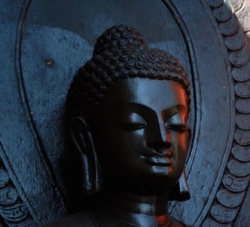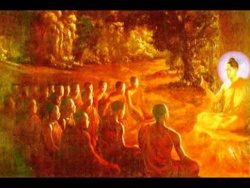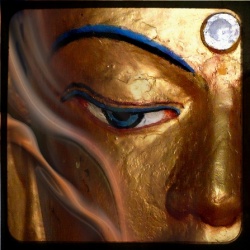Difference between revisions of "Understanding Dependent Origination (paticca samuppada)"
m (Text replacement - "first stage" to "first stage") |
|||
| (4 intermediate revisions by 3 users not shown) | |||
| Line 2: | Line 2: | ||
Getting at [[Sidharta Gotama’s]] [[philosophy]] of [[Dependent Origination]] I believe requires [[realizing]] that the [[Buddha]] and his [[people]] were really working from a different world-view than that of the contemporary {{Wiki|Western}} world-view, thus it is rather difficult to simply translate the words of the [[Buddha]] literally and end up with something cogent at the other end. | Getting at [[Sidharta Gotama’s]] [[philosophy]] of [[Dependent Origination]] I believe requires [[realizing]] that the [[Buddha]] and his [[people]] were really working from a different world-view than that of the contemporary {{Wiki|Western}} world-view, thus it is rather difficult to simply translate the words of the [[Buddha]] literally and end up with something cogent at the other end. | ||
[[File:5740449 n.jpg|thumb|250px|]][[File:024 n.jpg|thumb|250px|]] | [[File:5740449 n.jpg|thumb|250px|]][[File:024 n.jpg|thumb|250px|]] | ||
| − | A literal translation in the hands of someone who does not either understand [[Dependent Origination]] or the {{Wiki|Western}} world-view typically produces unsuccessful compound terms, such as " [[mentality]] materiality," “[[sense]] [[contact]]” and “[[eye consciousness]],” which produces a lot of the [[Dependent Origination]] double talk and [[Pali]] speak that seems to pervade the [[Buddha’s]] {{Wiki|discourse}} in {{Wiki|English}} translation. | + | A literal translation in the hands of someone who does not either understand [[Dependent Origination]] or the {{Wiki|Western}} world-view typically produces unsuccessful compound terms, such as " [[mentality]] [[materiality]]," “[[sense]] [[contact]]” and “[[eye consciousness]],” which produces a lot of the [[Dependent Origination]] double talk and [[Pali]] speak that seems to pervade the [[Buddha’s]] {{Wiki|discourse}} in {{Wiki|English}} translation. |
[[File:10.jpg|thumb|250px|]][[File:9 81249.jpg|thumb|250px|]] | [[File:10.jpg|thumb|250px|]][[File:9 81249.jpg|thumb|250px|]] | ||
| − | When one reads clumsy compound {{Wiki|English}} terms, such as mentioned above, we can conclude the [[person]] is either not familiar with the {{Wiki|Western}} [[language]] of [[cognition]] and/or does not understand the [[Buddha’s]] [[philosophy]] on [[Dependent Origination]]. It is clear to this contemplative that one must understand both to be able to clearly articulate [[Dependent Origination]] to the {{Wiki|Western}} [[people]]. | + | When one reads clumsy compound {{Wiki|English}} terms, such as mentioned above, we can conclude the [[person]] is either not familiar with the {{Wiki|Western}} [[language]] of [[cognition]] and/or does not understand the [[Buddha’s]] [[philosophy]] on [[Dependent Origination]]. It is clear to this {{Wiki|contemplative}} that one must understand both to be able to clearly articulate [[Dependent Origination]] to the {{Wiki|Western}} [[people]]. |
[[File:0fe.jpg|thumb|250px|]][[File:Atta.jpg|thumb|250px|]] | [[File:0fe.jpg|thumb|250px|]][[File:Atta.jpg|thumb|250px|]] | ||
| − | In {{Wiki|Western}} {{Wiki|psychology}} we use terms like: neurophysiology and psycho [[soma]] to get at the same {{Wiki|concept}} as the rather clumsy "[[mentality]] materiality;" sensory {{Wiki|stimuli}} for “[[sense organ]] [[contact]];” and [[cognition]] for the incorrect translation of [[viññana]] as “[[Consciousness]].” | + | In {{Wiki|Western}} {{Wiki|psychology}} we use terms like: neurophysiology and {{Wiki|psycho}} [[soma]] to get at the same {{Wiki|concept}} as the rather clumsy "[[mentality]] [[materiality]];" sensory {{Wiki|stimuli}} for “[[sense organ]] [[contact]];” and [[cognition]] for the incorrect translation of [[viññana]] as “[[Consciousness]].” |
[[File:0rgg.jpg|thumb|250px|]][[File:Buddha-4023.jpg|thumb|250px|]] | [[File:0rgg.jpg|thumb|250px|]][[File:Buddha-4023.jpg|thumb|250px|]] | ||
It is very possible that some [[dharma]] [[teacher]] think if they can make their explanation of dependent Origination really opaque, then (s)he will look really cool instead of too dull to understand the rather elegant [[principle]] it is. | It is very possible that some [[dharma]] [[teacher]] think if they can make their explanation of dependent Origination really opaque, then (s)he will look really cool instead of too dull to understand the rather elegant [[principle]] it is. | ||
| − | If we were to consider that the [[Four Noble Truths]] were the [[Buddha's]] [[master's]] thesis, then we could extend that {{Wiki|metaphor}} to say that [[Dependent Origination]] was the [[Buddha's]] {{Wiki|Dissertation}} on the same [[subject]]. | + | If we were to consider that the [[Four Noble Truths]] were the [[Buddha's]] [[master's]] {{Wiki|thesis}}, then we could extend that {{Wiki|metaphor}} to say that [[Dependent Origination]] was the [[Buddha's]] {{Wiki|Dissertation}} on the same [[subject]]. |
{{Centre|'''[[Four Noble Truths]]}} | {{Centre|'''[[Four Noble Truths]]}} | ||
<div align="center"> | <div align="center"> | ||
| Line 44: | Line 44: | ||
| 6 | | 6 | ||
| [[Cognition]] | | [[Cognition]] | ||
| − | |}</div><p>To expand his thesis on the [[Four Noble Truths]] into the equivalent of a {{Wiki|dissertation}} [[Sidharta Gotama]] articulated the domains of [[grasping]], which he called the [[Five Aggregates]] ([[skhanda]]/[[khandas]]) of [[clinging]] which [[cause]] the [[arising]] and passing away of [[formations]] (pancha-upadana-skanda):</p><p align="center"><strong>The [[Five Aggregates]] ([[khandas]]/[[skhandas]]) of [[Cognition]] to which we [[clinging]]:</strong></p><div align="center"> | + | |}</div><p>To expand his {{Wiki|thesis}} on the [[Four Noble Truths]] into the {{Wiki|equivalent}} of a {{Wiki|dissertation}} [[Sidharta Gotama]] articulated the domains of [[grasping]], which he called the [[Five Aggregates]] ([[skhanda]]/[[khandas]]) of [[clinging]] which [[cause]] the [[arising]] and passing away of [[formations]] (pancha-upadana-skanda):</p><p align="center"><strong>The [[Five Aggregates]] ([[khandas]]/[[skhandas]]) of [[Cognition]] to which we [[clinging]]:</strong></p><div align="center"> |
{| border="1" width="75%" | {| border="1" width="75%" | ||
| <p>1 </p> | | <p>1 </p> | ||
| Line 68: | Line 68: | ||
| − | In his exposition of [[Dependent Origination]] [[Sidharta Gotama]] relied heavily upon the {{Wiki|Vedic}} {{Wiki|concept}} of [[nama-rupa]]. [[Nama-rupa]] in that system is a way of describing the [[Universe]] in a [[dualistic]] world-view of a [[material universe]] verses a [[spiritual]] one. And, in the [[yogas]] one was to traverse both domains to end up [[beyond]] both nama-and [[rupa]] in a non-dualist domain of union with [[Brahma]]. | + | In his [[exposition]] of [[Dependent Origination]] [[Sidharta Gotama]] relied heavily upon the {{Wiki|Vedic}} {{Wiki|concept}} of [[nama-rupa]]. [[Nama-rupa]] in that system is a way of describing the [[Universe]] in a [[dualistic]] world-view of a [[material universe]] verses a [[spiritual]] one. And, in the [[yogas]] one was to traverse both domains to end up [[beyond]] both nama-and [[rupa]] in a non-dualist domain of union with [[Brahma]]. |
In the {{Wiki|Vedic}} use of these terms, [[Nama]] means the names of [[objects]]. This is translated under the [[Buddha]] to be the [[mind]], as well as [[Wikipedia:concept|concepts]]. [[Rupa]], in the [[Vedas]] means [[form]], the [[Buddha]] extended this to mean the [[physical body]]. | In the {{Wiki|Vedic}} use of these terms, [[Nama]] means the names of [[objects]]. This is translated under the [[Buddha]] to be the [[mind]], as well as [[Wikipedia:concept|concepts]]. [[Rupa]], in the [[Vedas]] means [[form]], the [[Buddha]] extended this to mean the [[physical body]]. | ||
| − | In short in the [[Vedas]] [[nama-rupa]] [[essentially]] meant the surface {{Wiki|texture}} of [[life]] that [[people]] get hung up on ([[attached]] to or [[grasp]] at). When he articulated [[Dependent Origination]], [[Sidharta Gotama]] extended the {{Wiki|metaphor}} of [[nama-rupa]] to apply it to what {{Wiki|Western}} {{Wiki|psychologists}} call the neurophysiology and the psycho [[soma]]. I believe he also wanted to [[rest]] the {{Wiki|concept}} from its {{Wiki|dependence}} upon [[theism]]. I think it was rather brilliant of him really. In so doing he was able to [[manifest]] an {{Wiki|ancient}} version of what we call “{{Wiki|psychology}}.” | + | In short in the [[Vedas]] [[nama-rupa]] [[essentially]] meant the surface {{Wiki|texture}} of [[life]] that [[people]] get hung up on ([[attached]] to or [[grasp]] at). When he articulated [[Dependent Origination]], [[Sidharta Gotama]] extended the {{Wiki|metaphor}} of [[nama-rupa]] to apply it to what {{Wiki|Western}} {{Wiki|psychologists}} call the neurophysiology and the {{Wiki|psycho}} [[soma]]. I believe he also wanted to [[rest]] the {{Wiki|concept}} from its {{Wiki|dependence}} upon [[theism]]. I think it was rather brilliant of him really. In so doing he was able to [[manifest]] an {{Wiki|ancient}} version of what we call “{{Wiki|psychology}}.” |
| − | Sidharta Gotama's [[idea]] was to separate out the various aspects of the [[Wikipedia:cognition|cognitive]] {{Wiki|processes}}, or what he called the [[skhandas]], and to strip them away in order to end up with a single product, an [[enlightened]] [[mind]], at the end. Thus he ended up with [[Body]], Sensory {{Wiki|Stimuli}}, [[Perception]], [[Mental]] Structures, and [[Cognition]] for the [[aggregates]] or skhandas. In the simplest rendition of this {{Wiki|concept}} one simply strips away [[objectification]] of the [[body]], the [[senses]], [[perception]], and [[emotions]] and [[Wikipedia:concept|concepts]] to reveal [[pure]] [[awareness]]. | + | Sidharta [[Gotama's]] [[idea]] was to separate out the various aspects of the [[Wikipedia:cognition|cognitive]] {{Wiki|processes}}, or what he called the [[skhandas]], and to strip them away in order to end up with a single product, an [[enlightened]] [[mind]], at the end. Thus he ended up with [[Body]], {{Wiki|Sensory}} {{Wiki|Stimuli}}, [[Perception]], [[Mental]] Structures, and [[Cognition]] for the [[aggregates]] or [[skhandas]]. In the simplest rendition of this {{Wiki|concept}} one simply strips away [[objectification]] of the [[body]], the [[senses]], [[perception]], and [[emotions]] and [[Wikipedia:concept|concepts]] to reveal [[pure]] [[awareness]]. |
| − | To simplify this for the {{Wiki|Western}} educated reader so it doesn't take book-length [[form]], I like to [[view]] the [[Five Aggregates]] ([[khandas]]) as the [[Wikipedia:cognition|cognitive]] {{Wiki|processes}}, [[thinking]], {{Wiki|reasoning}}, [[memory]], [[perception]] and [[awareness]]. [[Understanding]] the [[object]] of the [[Buddha's]] entire trajectory, which was [[cessation]] ([[nibbana]]), then we can see that [[cessation]], to the [[Buddha]], was the stopping or ceasing of [[grasping]] and [[aversion]] at the [[Wikipedia:cognition|cognitive]] {{Wiki|processes}}, which through a rigorous contemplative practice would leave us ultimately with the last of the [[Wikipedia:cognition|cognitive]] {{Wiki|processes}} alone, [[awareness]]. At [[cessation]] ([[nibbana]]) then, we become [[awareness]] only. | + | To simplify this for the {{Wiki|Western}} educated reader so it doesn't take book-length [[form]], I like to [[view]] the [[Five Aggregates]] ([[khandas]]) as the [[Wikipedia:cognition|cognitive]] {{Wiki|processes}}, [[thinking]], {{Wiki|reasoning}}, [[memory]], [[perception]] and [[awareness]]. [[Understanding]] the [[object]] of the [[Buddha's]] entire trajectory, which was [[cessation]] ([[nibbana]]), then we can see that [[cessation]], to the [[Buddha]], was the stopping or ceasing of [[grasping]] and [[aversion]] at the [[Wikipedia:cognition|cognitive]] {{Wiki|processes}}, which through a rigorous {{Wiki|contemplative}} practice would leave us ultimately with the last of the [[Wikipedia:cognition|cognitive]] {{Wiki|processes}} alone, [[awareness]]. At [[cessation]] ([[nibbana]]) then, we become [[awareness]] only. |
| − | It is through entering the absorption states ([[jhanas]]) that we actually traverse the [[aggregates]] of [[cognition]] ([[skhandas]]). You will notice from the list above of [[skhandas]] that the [[physical]] [[aggregate]] ([[rupa]]) is the first on the list. When one begins to explore the absorption states (please see the list below) one progressively sheds the [[aggregates]]. Such that when one enters into the first stage of absorption the first [[aggregate]], the [[physical body]] ([[rupa]]), is mostly relinquished or shed as a structure of [[ego]] {{Wiki|identification}}. By the second stage of absorption the [[mental]] [[aggregate]] ([[nama]]) as represented by [[sañkhara]] is relinquished as revealed by the [[cessation]] of [[vitakka]] and [[vicára]]. | + | It is through entering the [[absorption]] states ([[jhanas]]) that we actually traverse the [[aggregates]] of [[cognition]] ([[skhandas]]). You will notice from the list above of [[skhandas]] that the [[physical]] [[aggregate]] ([[rupa]]) is the first on the list. When one begins to explore the [[absorption]] states (please see the list below) one progressively sheds the [[aggregates]]. Such that when one enters into the first stage of [[absorption]] the first [[aggregate]], the [[physical body]] ([[rupa]]), is mostly relinquished or shed as a structure of [[ego]] {{Wiki|identification}}. By the second stage of [[absorption]] the [[mental]] [[aggregate]] ([[nama]]) as represented by [[sañkhara]] is relinquished as revealed by the [[cessation]] of [[vitakka]] and [[vicára]]. |
| − | <p align="center"><strong>The Four Material Ecstasies</strong><strong>, [[meditative]] absorption states ([[rupa jhanas]])</strong><strong> "[[samprajana-samadhi]]" </strong><strong>where there is [[awareness]] of the {{Wiki|material}} [[senses]]:</strong></p><p align="center">1- The [[first jhana]] ([[Bliss]]) contains 5 [[jhana]] factors and 1 factor of [[enlightenment]], the 6th factor ([[Piti]]) is acquired:</p><div align="center"> | + | <p align="center"><strong>The Four Material {{Wiki|Ecstasies}}</strong><strong>, [[meditative]] [[absorption]] states ([[rupa jhanas]])</strong><strong> "[[samprajana-samadhi]]" </strong><strong>where there is [[awareness]] of the {{Wiki|material}} [[senses]]:</strong></p><p align="center">1- The [[first jhana]] ([[Bliss]]) contains 5 [[jhana]] factors and 1 factor of [[enlightenment]], the 6th factor ([[Piti]]) is acquired:</p><div align="center"> |
{| border="1" width="75%" | {| border="1" width="75%" | ||
| <p>[[Vitakka]]</p> | | <p>[[Vitakka]]</p> | ||
| Line 146: | Line 146: | ||
|}</div> | |}</div> | ||
| − | The [[Pali]] terms [[vitakka]] and [[vicára]] have a range of meaning in the [[Buddha’s]] discourses, but most often they mean the [[Wikipedia:cognition|cognitive]] {{Wiki|processes}} of [[thinking]] and {{Wiki|reasoning}}, but when applied to access to absorption then they also mean applied and sustained [[concentration]]. | + | The [[Pali]] terms [[vitakka]] and [[vicára]] have a range of meaning in the [[Buddha’s]] [[discourses]], but most often they mean the [[Wikipedia:cognition|cognitive]] {{Wiki|processes}} of [[thinking]] and {{Wiki|reasoning}}, but when applied to access to [[absorption]] then they also mean applied and sustained [[concentration]]. |
| − | Access to the first stage of absorption relies upon occupying [[thinking]] and {{Wiki|reasoning}} and directing these [[Wikipedia:cognition|cognitive]] {{Wiki|processes}} toward a [[meditation]] [[object]] through applied and sustained [[concentration]]. Once the [[aggregates]] of [[thinking]] and {{Wiki|reasoning}} ([[vitakka]] and vicára) have been left behind, then one enters the second stage of absorption. | + | Access to the first stage of [[absorption]] relies upon occupying [[thinking]] and {{Wiki|reasoning}} and directing these [[Wikipedia:cognition|cognitive]] {{Wiki|processes}} toward a [[meditation]] [[object]] through applied and sustained [[concentration]]. Once the [[aggregates]] of [[thinking]] and {{Wiki|reasoning}} ([[vitakka]] and [[vicára]]) have been left behind, then one enters the second stage of [[absorption]]. |
When the [[aggregates]] of [[physical]] sensory {{Wiki|stimuli}} and most of the [[Wikipedia:cognition|cognitive]] {{Wiki|processes}} have been removed then one enters the non-material absorptions. Finally, one enters [[nibbana]] when all of the [[aggregates]] of [[cognition]], except [[awareness]] are relinquished or ended. | When the [[aggregates]] of [[physical]] sensory {{Wiki|stimuli}} and most of the [[Wikipedia:cognition|cognitive]] {{Wiki|processes}} have been removed then one enters the non-material absorptions. Finally, one enters [[nibbana]] when all of the [[aggregates]] of [[cognition]], except [[awareness]] are relinquished or ended. | ||
| − | The [[objects]] of the [[senses]] are tantalizing, and {{Wiki|seductive}}. It is not that they are "bad" or "[[evil]]." They are simply distractions that we keep distracting ourselves with until we grow tired of them. In between, [[time]] one who is intent upon [[enlightenment]] in the shortest possible [[time]], simply turns and returns to one's [[spiritual]] practice ([[vitakka]] and vicára), which is not just [[meditating]] 2 to 4 times a day, but bringing [[mindfulness]] to every moment. | + | The [[objects]] of the [[senses]] are tantalizing, and {{Wiki|seductive}}. It is not that they are "bad" or "[[evil]]." They are simply distractions that we keep distracting ourselves with until we grow tired of them. In between, [[time]] one who is intent upon [[enlightenment]] in the shortest possible [[time]], simply turns and returns to one's [[spiritual]] practice ([[vitakka]] and [[vicára]]), which is not just [[meditating]] 2 to 4 times a day, but bringing [[mindfulness]] to every moment. |
| − | When we bring [[mindfulness]] to every moment, then we see the [[clinging]] we have for the [[objects]] of the [[senses]] and the [[Wikipedia:cognition|cognitive]] {{Wiki|processes}}. And, we eventually develop the ability to relinquish [[clinging]], upon sensory {{Wiki|stimulation}} and [[cognition]]. Eventually the [[objects]] of the [[senses]] and [[cognition]] do not even pull our [[attention]] away from the [[bliss]] of absorption ([[jhana]]). | + | When we bring [[mindfulness]] to every moment, then we see the [[clinging]] we have for the [[objects]] of the [[senses]] and the [[Wikipedia:cognition|cognitive]] {{Wiki|processes}}. And, we eventually develop the ability to relinquish [[clinging]], upon sensory {{Wiki|stimulation}} and [[cognition]]. Eventually the [[objects]] of the [[senses]] and [[cognition]] do not even pull our [[attention]] away from the [[bliss]] of [[absorption]] ([[jhana]]). |
| − | When we bring [[mindfulness]] to every moment, then we see the [[clinging]] we have for the [[objects]] of the [[senses]] and [[cognition]]. And, we eventually develop the ability to relinquish [[clinging]], upon sensory {{Wiki|stimulation}} and [[cognition]]. Eventually the [[objects]] of the [[senses]] and [[cognition]] do not even pull our [[attention]] away from the [[bliss]] of absorption ([[jhana]]). | + | When we bring [[mindfulness]] to every moment, then we see the [[clinging]] we have for the [[objects]] of the [[senses]] and [[cognition]]. And, we eventually develop the ability to relinquish [[clinging]], upon sensory {{Wiki|stimulation}} and [[cognition]]. Eventually the [[objects]] of the [[senses]] and [[cognition]] do not even pull our [[attention]] away from the [[bliss]] of [[absorption]] ([[jhana]]). |
| − | When one has developed moment-to-moment [[mindfulness]], then one may want to engage the [[mind]] in reflecting upon what the [[Buddha]] called the "three marks." The three marks are simply [[dissatisfaction]] ([[Dukkha]]), [[impermanence]] ([[Anicca]]) and no self-identification ([[Anatta]]). And, it goes like this: [[clinging]] to any sensible [[objects]] ([[anatta]]) [[causes]] [[dissatisfaction]] ([[dukkha]]) because its intrinsic {{Wiki|nature}} is to change ([[anicca]]). | + | When one has developed moment-to-moment [[mindfulness]], then one may want to engage the [[mind]] in {{Wiki|reflecting}} upon what the [[Buddha]] called the "three marks." The three marks are simply [[dissatisfaction]] ([[Dukkha]]), [[impermanence]] ([[Anicca]]) and no self-identification ([[Anatta]]). And, it goes like this: [[clinging]] to any sensible [[objects]] ([[anatta]]) [[causes]] [[dissatisfaction]] ([[dukkha]]) because its intrinsic {{Wiki|nature}} is to change ([[anicca]]). |
We [[cling]] to [[objects]] because we identify with them ([[anatta]]), therefore, as contemplatives, we seek to dis-identification, and stop objectifying, the [[objects]] of the [[senses]] and [[cognition]]. We do this by following a simple series of phrases: "This is not me. I am not this. This is not mine," for every [[object]] that arises to our [[perception]]. | We [[cling]] to [[objects]] because we identify with them ([[anatta]]), therefore, as contemplatives, we seek to dis-identification, and stop objectifying, the [[objects]] of the [[senses]] and [[cognition]]. We do this by following a simple series of phrases: "This is not me. I am not this. This is not mine," for every [[object]] that arises to our [[perception]]. | ||
| − | The psychosomatic aspect of [[Dependent Origination]] becomes relevant when one engages in the contemplative practices of the [[Buddha]]. These practices are described in three [[suttas]] under the {{Wiki|general}} heading of [[Satipatthana]], and they are known also as the "Four Cornerstones (foundations or pillars) of [[Mindfulness]]." Those four cornerstones are [[mindfulness]] of the [[Breath]], [[Body]], [[Senses]] and [[Mind]]. It is through relinquishing the [[objectification]] of the [[body]], the [[senses]] and [[sense objects]], the [[mind]] and [[mind]] [[objects]] that we inexorably arrive at [[cessation]] ([[nibbana]]). [[Mind]] [[objects]] are [[beliefs]], [[Wikipedia:concept|concepts]] and [[mental states]]. | + | The psychosomatic aspect of [[Dependent Origination]] becomes relevant when one engages in the {{Wiki|contemplative}} practices of the [[Buddha]]. These practices are described in three [[suttas]] under the {{Wiki|general}} heading of [[Satipatthana]], and they are known also as the "Four Cornerstones (foundations or pillars) of [[Mindfulness]]." Those four cornerstones are [[mindfulness]] of the [[Breath]], [[Body]], [[Senses]] and [[Mind]]. It is through relinquishing the [[objectification]] of the [[body]], the [[senses]] and [[sense objects]], the [[mind]] and [[mind]] [[objects]] that we inexorably arrive at [[cessation]] ([[nibbana]]). [[Mind]] [[objects]] are [[beliefs]], [[Wikipedia:concept|concepts]] and [[mental states]]. |
| − | If you have not read the [[Buddha's]] three discourses on [[meditation]] ([[Sati]]), this contemplative recently rendered a few editorial improvements in their translation, and they are available at these URLs: | + | If you have not read the [[Buddha's]] three [[discourses]] on [[meditation]] ([[Sati]]), this {{Wiki|contemplative}} recently rendered a few editorial improvements in their translation, and they are available at these URLs: |
[[Anapanasati Sutta]] (MN 118), Mindfulnes of the [[breath]] | [[Anapanasati Sutta]] (MN 118), Mindfulnes of the [[breath]] | ||
| Line 174: | Line 174: | ||
[[Maha-satipatthana Sutta]] (DN 22), the Great {{Wiki|Discourse}} on the Four Cornerstones of [[Mindfulness]] | [[Maha-satipatthana Sutta]] (DN 22), the Great {{Wiki|Discourse}} on the Four Cornerstones of [[Mindfulness]] | ||
| − | It is the very psychosomatic aspect of [[Dependent Origination]] that leads this contemplative to believe that it would not be too far fetched to speculate that the originators of {{Wiki|Western}} {{Wiki|Psychology}}, from {{Wiki|Freud}} and Young to De Graf, had been reading {{Wiki|translations}} of [[Buddhist]] {{Wiki|literature}}, and were thus exposed to the [[Wikipedia:concept|concepts]] of [[Dependent Origination]]. So, it is very possible most of the key players in {{Wiki|Western}} {{Wiki|Psychology}} and the somatic {{Wiki|movement}} may have been influenced by [[Buddhism]]. Why they didn't contribute to the {{Wiki|Western}} [[understanding]] of [[Buddhism]] I do not know, however their [[Wikipedia:concept|concepts]] of {{Wiki|Western}} {{Wiki|psychology}} seem to be a fairly brilliant [[understanding]] of [[Dependent Origination]]. | + | It is the very psychosomatic aspect of [[Dependent Origination]] that leads this {{Wiki|contemplative}} to believe that it would not be too far fetched to speculate that the originators of {{Wiki|Western}} {{Wiki|Psychology}}, from {{Wiki|Freud}} and Young to De Graf, had been reading {{Wiki|translations}} of [[Buddhist]] {{Wiki|literature}}, and were thus exposed to the [[Wikipedia:concept|concepts]] of [[Dependent Origination]]. So, it is very possible most of the key players in {{Wiki|Western}} {{Wiki|Psychology}} and the somatic {{Wiki|movement}} may have been influenced by [[Buddhism]]. Why they didn't contribute to the {{Wiki|Western}} [[understanding]] of [[Buddhism]] I do not know, however their [[Wikipedia:concept|concepts]] of {{Wiki|Western}} {{Wiki|psychology}} seem to be a fairly brilliant [[understanding]] of [[Dependent Origination]]. |
In the [[Buddha's]] {{Wiki|concept}} of [[Dependent Origination]] he expressed a deep [[understanding]] of how [[humans]] tend to objectify their [[world]] and thus maintain the [[Wikipedia:cognition|cognitive]] structure we call “[[ego]].” He also understood how we can only know our [[world]] through the [[senses]] and [[sense]] [[perception]]. Once he had arrived at [[nibbana]] he [[realized]] it was our [[objectification]] of our sensory [[world]] that keeps us from being [[enlightened]]. It is our [[ego]] {{Wiki|identification}} with the neurophysiology ([[nama-rupa]]), that [[forms]] the [[beliefs]] and [[Wikipedia:concept|concepts]] about the [[body]] and it sensory domain ([[rupa]]), and the [[mind]] and its [[Wikipedia:cognition|cognitive]] domain ([[nama]]) that keeps us [[attached]] to this [[human]] [[form]] [[lifetime]] after [[lifetime]] and thus from being free of [[suffering]] and [[enlightened]] by [[realizing]] our [[infinite]] [[existence]]. | In the [[Buddha's]] {{Wiki|concept}} of [[Dependent Origination]] he expressed a deep [[understanding]] of how [[humans]] tend to objectify their [[world]] and thus maintain the [[Wikipedia:cognition|cognitive]] structure we call “[[ego]].” He also understood how we can only know our [[world]] through the [[senses]] and [[sense]] [[perception]]. Once he had arrived at [[nibbana]] he [[realized]] it was our [[objectification]] of our sensory [[world]] that keeps us from being [[enlightened]]. It is our [[ego]] {{Wiki|identification}} with the neurophysiology ([[nama-rupa]]), that [[forms]] the [[beliefs]] and [[Wikipedia:concept|concepts]] about the [[body]] and it sensory domain ([[rupa]]), and the [[mind]] and its [[Wikipedia:cognition|cognitive]] domain ([[nama]]) that keeps us [[attached]] to this [[human]] [[form]] [[lifetime]] after [[lifetime]] and thus from being free of [[suffering]] and [[enlightened]] by [[realizing]] our [[infinite]] [[existence]]. | ||
Latest revision as of 09:41, 9 February 2016
Getting at Sidharta Gotama’s philosophy of Dependent Origination I believe requires realizing that the Buddha and his people were really working from a different world-view than that of the contemporary Western world-view, thus it is rather difficult to simply translate the words of the Buddha literally and end up with something cogent at the other end.
A literal translation in the hands of someone who does not either understand Dependent Origination or the Western world-view typically produces unsuccessful compound terms, such as " mentality materiality," “sense contact” and “eye consciousness,” which produces a lot of the Dependent Origination double talk and Pali speak that seems to pervade the Buddha’s discourse in English translation.
When one reads clumsy compound English terms, such as mentioned above, we can conclude the person is either not familiar with the Western language of cognition and/or does not understand the Buddha’s philosophy on Dependent Origination. It is clear to this contemplative that one must understand both to be able to clearly articulate Dependent Origination to the Western people.
In Western psychology we use terms like: neurophysiology and psycho soma to get at the same concept as the rather clumsy "mentality materiality;" sensory stimuli for “sense organ contact;” and cognition for the incorrect translation of viññana as “Consciousness.”
It is very possible that some dharma teacher think if they can make their explanation of dependent Origination really opaque, then (s)he will look really cool instead of too dull to understand the rather elegant principle it is.
If we were to consider that the Four Noble Truths were the Buddha's master's thesis, then we could extend that metaphor to say that Dependent Origination was the Buddha's Dissertation on the same subject.
1 |
Dissatisfaction and suffering (dukkha) exist |
| 2 | Dissatisfaction and suffering have an origin |
| 3 | The origin of dissatisfaction and suffering (dukkha) is grasping (tanhá) |
| 4 | There is a path that leads one out of dissatisfaction and suffering (dukkha). That path is the Noble Eight Fold Path |
In Dependent Origination the Buddha applied the concept that grasping and aversion, as the causes of dissatisfaction, were the cause of arising and passing away of all sensory phenomena in the 6 senses.
The 6 Senses (áyatana) according to the Buddha:
To expand his thesis on the Four Noble Truths into the equivalent of a dissertation Sidharta Gotama articulated the domains of grasping, which he called the Five Aggregates (skhanda/khandas) of clinging which cause the arising and passing away of formations (pancha-upadana-skanda):
The Five Aggregates (khandas/skhandas) of Cognition to which we clinging:
1 |
Body, matter, physical form | rupa |
| 2 | Sensuality, sensory stimuli | vedana |
3 |
Perception | sañña |
| 4 | Mental structures, states and objects | sañkhara |
5 |
Cognition | viññana |
In his exposition of Dependent Origination Sidharta Gotama relied heavily upon the Vedic concept of nama-rupa. Nama-rupa in that system is a way of describing the Universe in a dualistic world-view of a material universe verses a spiritual one. And, in the yogas one was to traverse both domains to end up beyond both nama-and rupa in a non-dualist domain of union with Brahma.
In the Vedic use of these terms, Nama means the names of objects. This is translated under the Buddha to be the mind, as well as concepts. Rupa, in the Vedas means form, the Buddha extended this to mean the physical body.
In short in the Vedas nama-rupa essentially meant the surface texture of life that people get hung up on (attached to or grasp at). When he articulated Dependent Origination, Sidharta Gotama extended the metaphor of nama-rupa to apply it to what Western psychologists call the neurophysiology and the psycho soma. I believe he also wanted to rest the concept from its dependence upon theism. I think it was rather brilliant of him really. In so doing he was able to manifest an ancient version of what we call “psychology.”
Sidharta Gotama's idea was to separate out the various aspects of the cognitive processes, or what he called the skhandas, and to strip them away in order to end up with a single product, an enlightened mind, at the end. Thus he ended up with Body, Sensory Stimuli, Perception, Mental Structures, and Cognition for the aggregates or skhandas. In the simplest rendition of this concept one simply strips away objectification of the body, the senses, perception, and emotions and concepts to reveal pure awareness.
To simplify this for the Western educated reader so it doesn't take book-length form, I like to view the Five Aggregates (khandas) as the cognitive processes, thinking, reasoning, memory, perception and awareness. Understanding the object of the Buddha's entire trajectory, which was cessation (nibbana), then we can see that cessation, to the Buddha, was the stopping or ceasing of grasping and aversion at the cognitive processes, which through a rigorous contemplative practice would leave us ultimately with the last of the cognitive processes alone, awareness. At cessation (nibbana) then, we become awareness only.
It is through entering the absorption states (jhanas) that we actually traverse the aggregates of cognition (skhandas). You will notice from the list above of skhandas that the physical aggregate (rupa) is the first on the list. When one begins to explore the absorption states (please see the list below) one progressively sheds the aggregates. Such that when one enters into the first stage of absorption the first aggregate, the physical body (rupa), is mostly relinquished or shed as a structure of ego identification. By the second stage of absorption the mental aggregate (nama) as represented by sañkhara is relinquished as revealed by the cessation of vitakka and vicára.
The Four Material Ecstasies, meditative absorption states (rupa jhanas) "samprajana-samadhi" where there is awareness of the material senses:
1- The first jhana (Bliss) contains 5 jhana factors and 1 factor of enlightenment, the 6th factor (Piti) is acquired:
| applied or initiating attention | |
| Vicára | sustained attention |
| Sukha | joy |
| Piti | bliss |
| Ekaggatha | one-pointedness |
2- Second jhana (Tranquility) with no attention or Vitakka & Vicára needed, contains 4 jhana factors and 2 factors of enlightenment, the 3rd factor (Passaddhi) is acquired:
| joy | |
| Piiti | bliss |
| Ekaggatha | one-pointedness |
| Passaddhi | tranquillity |
| avitakka ca aicara | no applied or sustained attention |
3- Third jhana (Equanimity) contains 5 jhana factors and 3 factors of enlightenment, the 5th factor of enlightenment (Upekkha) is acquired:
4- Fourth jhana [freedom from joy and suffering (asukha and adukkha)] contains 4 jhana factors and 3 factors of enlightenment:
| Piiti | bliss |
| Ekaggatha | one-pointedness |
| Passaddhi | tranquillity |
| Upekkha | equanimity |
| Asukha ca Adukkha | no pleasure & no pain |
The Pali terms vitakka and vicára have a range of meaning in the Buddha’s discourses, but most often they mean the cognitive processes of thinking and reasoning, but when applied to access to absorption then they also mean applied and sustained concentration.
Access to the first stage of absorption relies upon occupying thinking and reasoning and directing these cognitive processes toward a meditation object through applied and sustained concentration. Once the aggregates of thinking and reasoning (vitakka and vicára) have been left behind, then one enters the second stage of absorption.
When the aggregates of physical sensory stimuli and most of the cognitive processes have been removed then one enters the non-material absorptions. Finally, one enters nibbana when all of the aggregates of cognition, except awareness are relinquished or ended.
The objects of the senses are tantalizing, and seductive. It is not that they are "bad" or "evil." They are simply distractions that we keep distracting ourselves with until we grow tired of them. In between, time one who is intent upon enlightenment in the shortest possible time, simply turns and returns to one's spiritual practice (vitakka and vicára), which is not just meditating 2 to 4 times a day, but bringing mindfulness to every moment.
When we bring mindfulness to every moment, then we see the clinging we have for the objects of the senses and the cognitive processes. And, we eventually develop the ability to relinquish clinging, upon sensory stimulation and cognition. Eventually the objects of the senses and cognition do not even pull our attention away from the bliss of absorption (jhana).
When we bring mindfulness to every moment, then we see the clinging we have for the objects of the senses and cognition. And, we eventually develop the ability to relinquish clinging, upon sensory stimulation and cognition. Eventually the objects of the senses and cognition do not even pull our attention away from the bliss of absorption (jhana).
When one has developed moment-to-moment mindfulness, then one may want to engage the mind in reflecting upon what the Buddha called the "three marks." The three marks are simply dissatisfaction (Dukkha), impermanence (Anicca) and no self-identification (Anatta). And, it goes like this: clinging to any sensible objects (anatta) causes dissatisfaction (dukkha) because its intrinsic nature is to change (anicca).
We cling to objects because we identify with them (anatta), therefore, as contemplatives, we seek to dis-identification, and stop objectifying, the objects of the senses and cognition. We do this by following a simple series of phrases: "This is not me. I am not this. This is not mine," for every object that arises to our perception.
The psychosomatic aspect of Dependent Origination becomes relevant when one engages in the contemplative practices of the Buddha. These practices are described in three suttas under the general heading of Satipatthana, and they are known also as the "Four Cornerstones (foundations or pillars) of Mindfulness." Those four cornerstones are mindfulness of the Breath, Body, Senses and Mind. It is through relinquishing the objectification of the body, the senses and sense objects, the mind and mind objects that we inexorably arrive at cessation (nibbana). Mind objects are beliefs, concepts and mental states.
If you have not read the Buddha's three discourses on meditation (Sati), this contemplative recently rendered a few editorial improvements in their translation, and they are available at these URLs:
Anapanasati Sutta (MN 118), Mindfulnes of the breath
Kayagata-sati Sutta, MN 119 “Mindfulness of the Body
Satipatthana Sutta (MN 10), the Four Cornerstones of Mindfulness
Maha-satipatthana Sutta (DN 22), the Great Discourse on the Four Cornerstones of Mindfulness
It is the very psychosomatic aspect of Dependent Origination that leads this contemplative to believe that it would not be too far fetched to speculate that the originators of Western Psychology, from Freud and Young to De Graf, had been reading translations of Buddhist literature, and were thus exposed to the concepts of Dependent Origination. So, it is very possible most of the key players in Western Psychology and the somatic movement may have been influenced by Buddhism. Why they didn't contribute to the Western understanding of Buddhism I do not know, however their concepts of Western psychology seem to be a fairly brilliant understanding of Dependent Origination.
In the Buddha's concept of Dependent Origination he expressed a deep understanding of how humans tend to objectify their world and thus maintain the cognitive structure we call “ego.” He also understood how we can only know our world through the senses and sense perception. Once he had arrived at nibbana he realized it was our objectification of our sensory world that keeps us from being enlightened. It is our ego identification with the neurophysiology (nama-rupa), that forms the beliefs and concepts about the body and it sensory domain (rupa), and the mind and its cognitive domain (nama) that keeps us attached to this human form lifetime after lifetime and thus from being free of suffering and enlightened by realizing our infinite existence.








